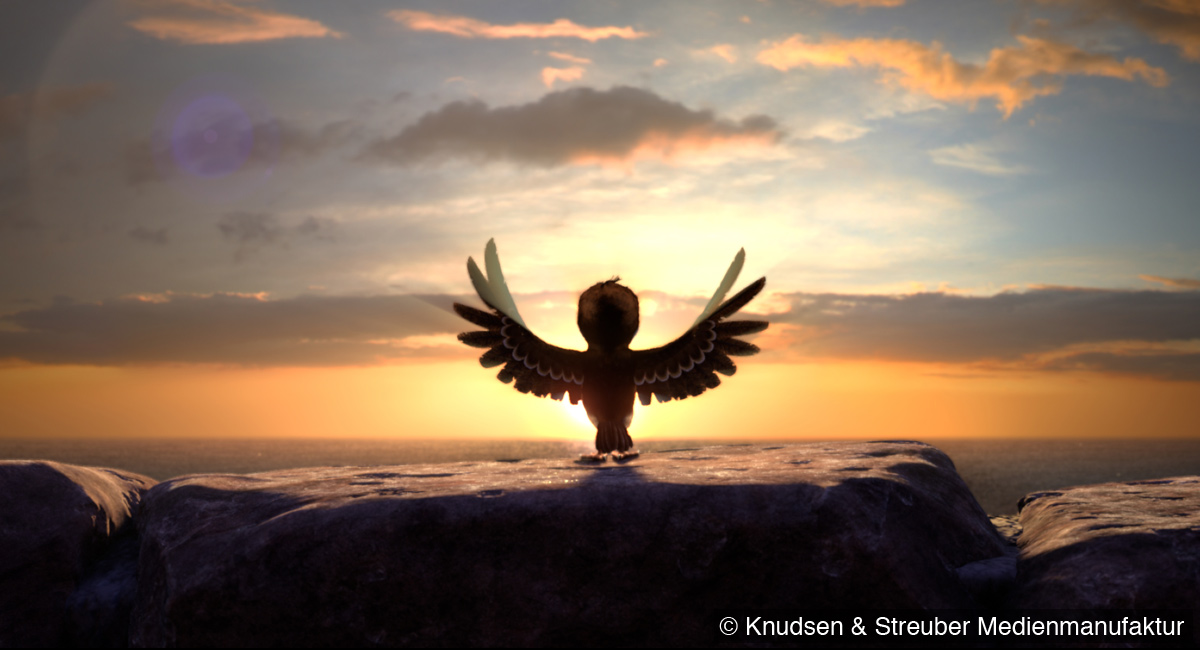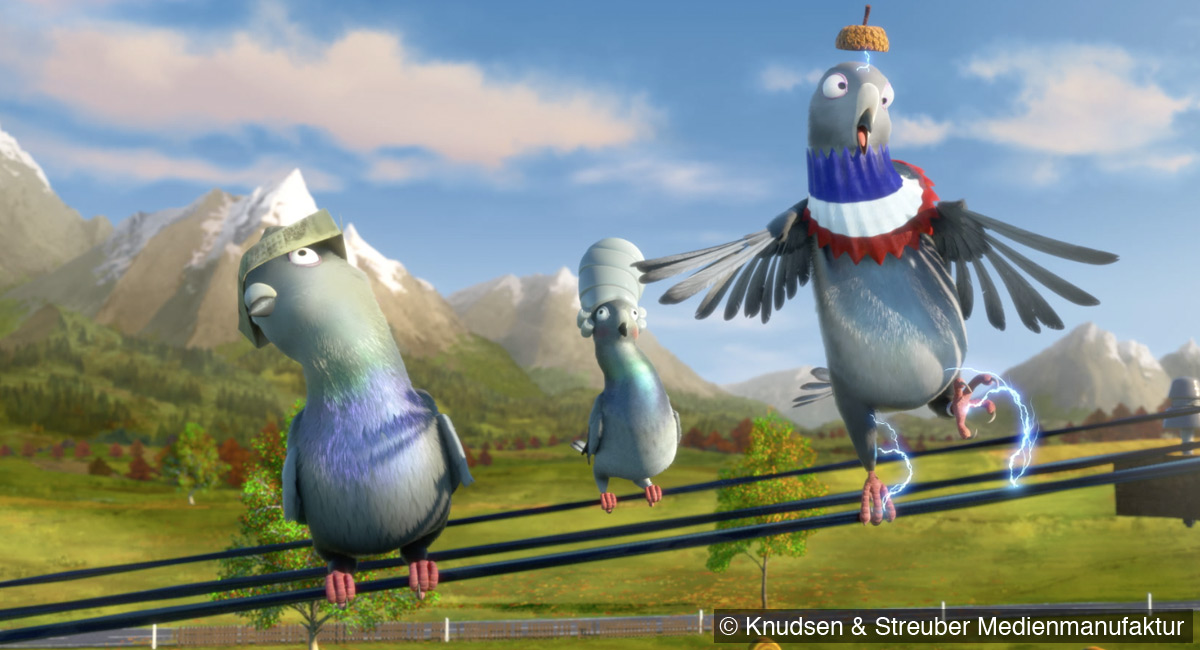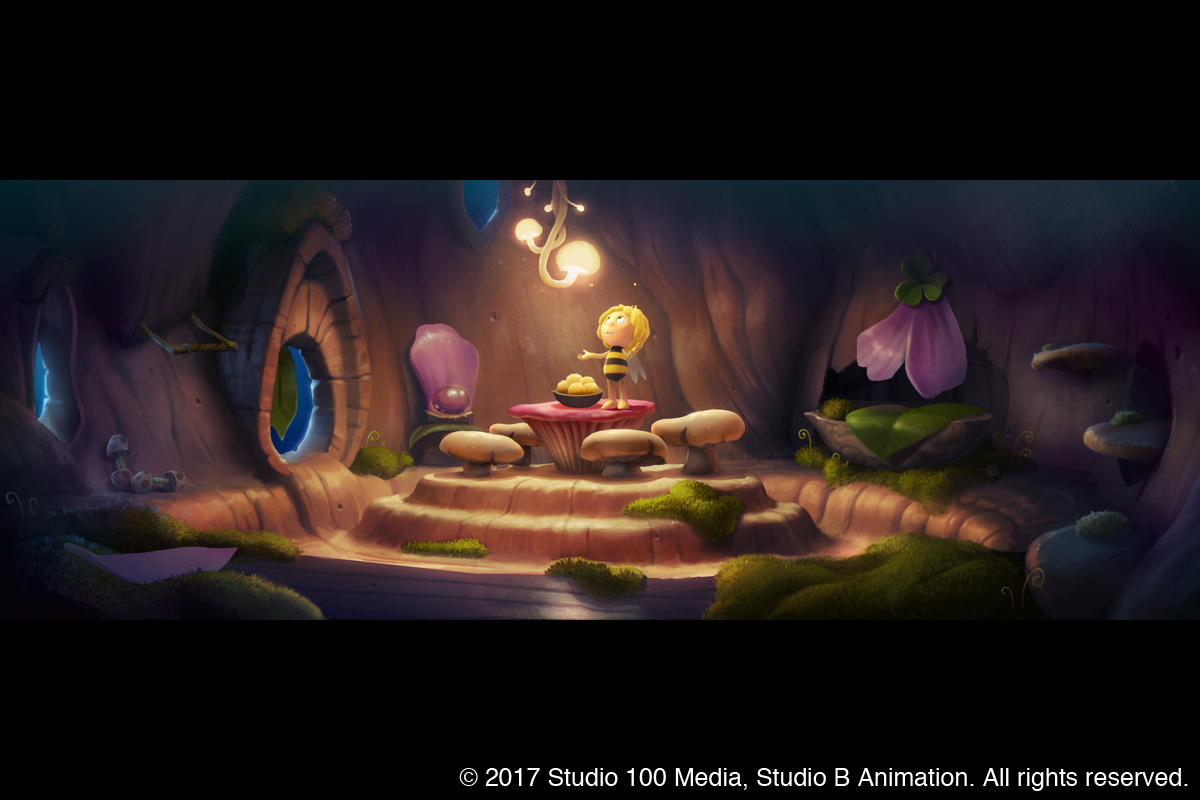Richard the Stork
(Status: in Post- Production)
[row][column size='1/4']
[caption id="attachment_5006" align="aligncenter" width="1200"]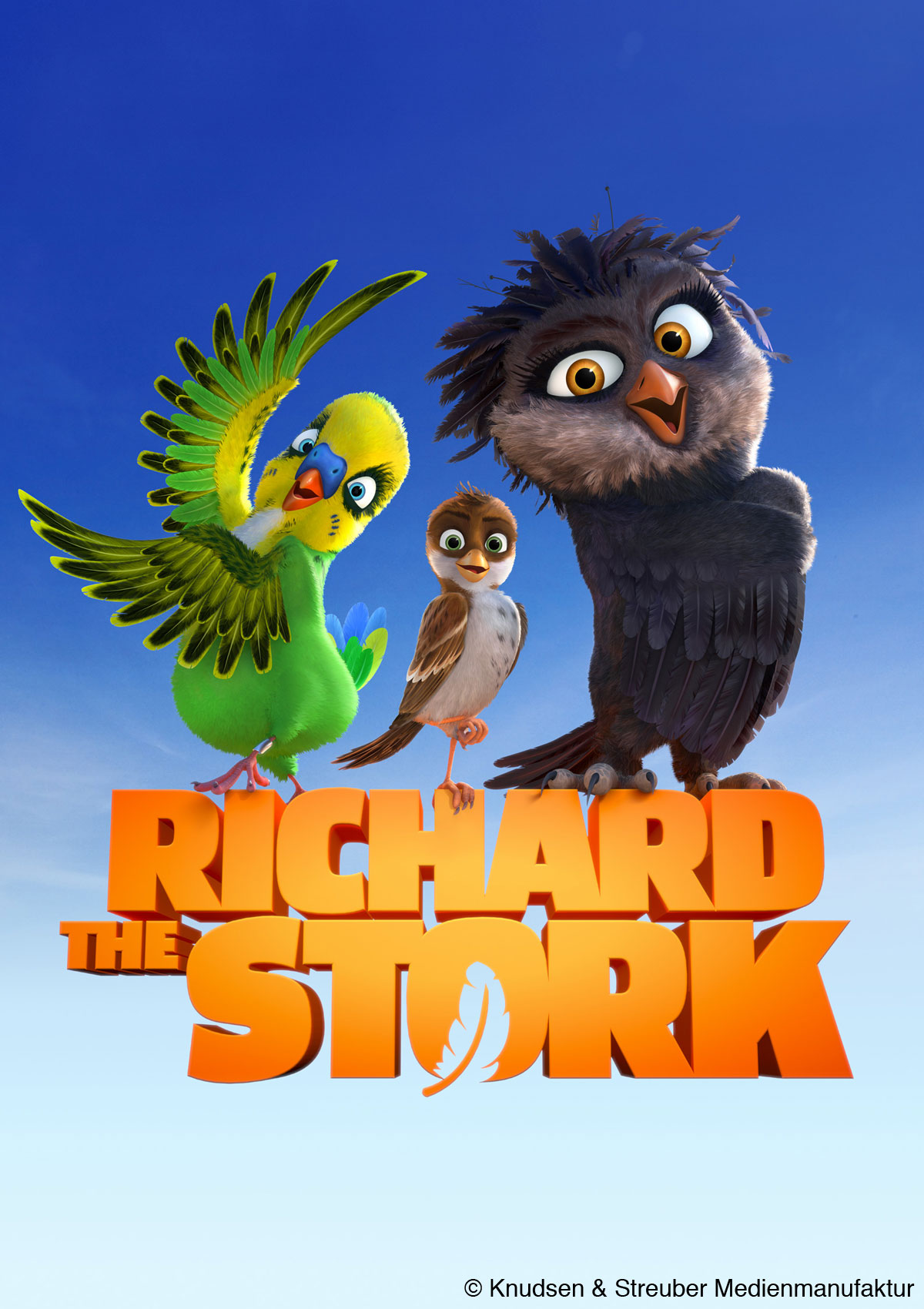 Teaser Poster[/caption]
Teaser Poster[/caption]
[/column]
[column size='3/4']
Synopsis
Richard is an orphaned sparrow who was raised by a stork family and believes he is one of them. But when the time comes to reveal his true identity and migrate to Africa without him, Richard chases after them to prove that he is a stork after all. His newfound buddies Olga, a pygmy owl with an imaginary friend, and Kiki, a narcissistic, disco-singing parakeet with a fear of heights, help the tiniest stork realize that in order to reach his goal he must learn to see himself as a great sparrow.
[/column]
[/row] [row]
[column size='1/2']
Richard the Stork
Director: Toby Genkel
Screenwriter & Co-Director: Reza Memari
Producer: Kristine Knudsen
Production companies: Knudsen & Streuber Medienmanufaktur (Berlin, GER), Ulysses Filmproduktion (Hamburg, GER), Walking the Dog (Brussels, BEL) Mélusine Productions (Luxembourg, LUX), Den siste skilling (Bergen, NOR), Senator Film München (Munich, GER).
Studios: RISE FX (Berlin, GER), Studio Rakete (Hamburg, GER), Walking the Dog (Brussels; BEL), Studio 352 (Luxembourg, LUX), BUG (Bergen, NOR) and Short Cut (Oslo, NOR).
Target audience: Family Entertainment
Technique: Stereo 3D CGI Animation
[/column]
[column size='1/2']
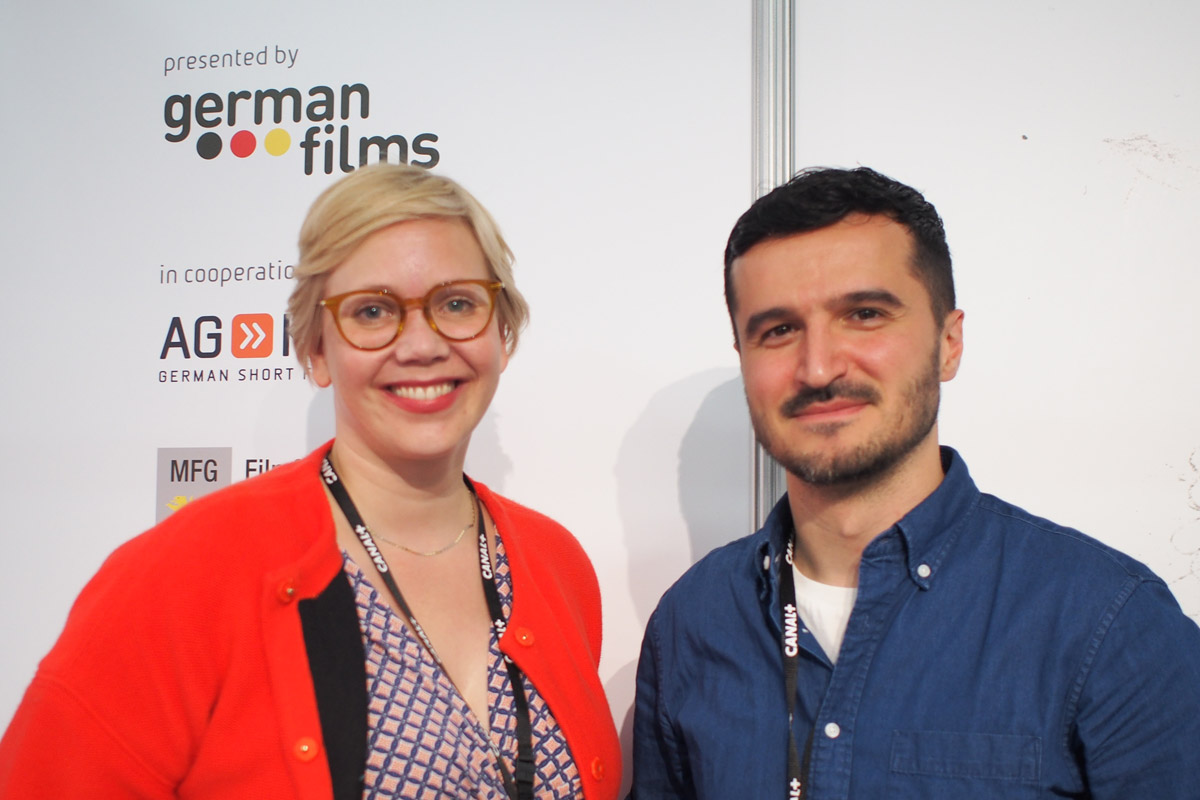
[/column]
[/row]
Animationweek had the chance to talk with screenwriter and co-director Reza Memari and producer Kristine Knudsen on a new CG-animated feature titled Richard the Stork at the Annecy International Animated Film Festival 2016. It is a co-production between studios in Germany, Belgium, Luxembourg and Norway. The story centres on a journey of an orphaned sparrow named Richard who is raised by storks and thinks he is a stork. He travels all the way to Africa to prove it to his stork family. His newfound pals Olga, a pygmy owl with an imaginary friend, and Kiki, a disco-singing parakeet with a fear of heights, help Richard, the tiniest stork, accept that he is a truly great sparrow.
The story of Richard’s journey happens to mirror the journey of Reza Memari and Kristine Knudsen, who are making their animated feature film debut with this original story. Their passion, strong determination and hard-work made it possible. This European independent CG animated film is to be released 1st Quarter of 2017 internationally. We are happy to be able to share their journey in animated film making to date with you.
Interview with Reza Memari and Kristine Knudsen
Starting from scratch
Animationweek (AW): Could you tell us when you started working together?
Reza Memari (RM): We started working together in 2008. It was totally cliché; basically we met at our friend’s birthday party. We were introduced to each other and I gave her a very bad pitch of my idea for Richard the Stork.
Kristine Knudsen (KK): No, you had the whole story figured out in your head. It’s not quite the same as the film now, but you had the whole narrative.
RM: Yes, it was about a little sparrow that finds it unfair that he can’t go to Africa. I didn’t have all the family stuff yet figured out, but there is a core question: “Why can’t I go to Africa?”. Then, Kristine asked me whether I could write it down. That´s how it started, it’s crazy.
KK: It was a very catchy story with classical storytelling, but with a personal touch. I was fascinated by it! I had produced several live action feature films, but this would be my first animated feature. The next step was that Reza wrote the screenplay.
RM: I had only written and directed three short films, but they were all live action.
AW: So are both of you coming from live action?
RM: Yes, we are. I didn’t have any animation experience.
KK: But we love this big epic classic with a modernised approach to storytelling in animation.
AW: Were you planning to make your story an animation from the beginning?
RM: Yes. In fact, I had the idea years earlier and I never gave it out or told anyone because I was so sure that this movie couldn’t be made in Germany. I said to myself, “To make this 3D animated film, I will have to become a famous moviemaker and live somewhere else, like America”. But Kristine said to me, “I don’t know how yet, but let’s try”.
KK: “Let’s try”. I think we are both not thinking in a conventional way. My idea was that we had to develop it so far that people just could not say no. You only get one chance. We really spent years developing it. Many years.
Inspiration to the story and its development
AW: What inspired you to come up with the initial idea of the story?
RM: It’s a strange thing, but I used to live in Munich and I was standing in front of a McDonalds with a friend. I was eating my burger and was watching sparrows steal fries from the ground and eating them, being happy and cute. And then I heard ducks, I looked up and I saw this ‘V’ shape of ducks going south. Then, I asked my friend the question, “Isn’t it unfair that sparrows have to stay in Germany in the winter and cannot go to Africa, where it’s warm?”. This one question led me to the story of the movie.
AW: How did you develop the script and the characters from that idea? Did you discuss the story with others?
RM: We spent maybe one or two years just in the treatment instead of going to storyboards with a kind-of okay script. I wrote it down first and then Kristine and her partner Tom Streuber were basically the first ones to give us feedback. Tom is also a screenwriter. We basically worked together, just the three of us, for a long time. I am very self-critical and I always wanted a big, commercial, universal story and I wanted it to be as polished as possible. I am my own worst enemy, I was always pushing myself: “No, this isn’t good enough, no, this isn’t good enough!” I was constantly trying to make it better and then at some point, we reached the point where we could move on to the screenplay. At that point, we felt like we needed someone who actually comes from the animation industry, who has written for animation, and who also knows practical things like how many 3D characters you can actually finance for a film. We found Ulla Ziemann, a veteran screenwriter with 20 years of experience in the German animation industry. I had a very big cast because it’s a road-trip movie. When she came in, she immediately removed half of the birds from the story.
KK: She also helped the focus of the film. If you have too many characters, you lose the focus. It wasn’t only about production concerns and cutting, but mostly about focusing the story.
RM: She definitely helped the storytelling and also brought in sensibility in terms of what we can do with animation. I had no limits at the very beginning, which was fun but then you had to be realistic. We worked together and then I went to a story lab called The Academy for Children’s Media (Akademie für Kindermedien) in Erfurt, Germany, a really good workshop. You go there for six months every other week, and you sit with four other people in the same room. We are all allowed to give notes on each other’s projects for feedback.
The course also includes a very experienced mentor, so I wanted to attend. Even though it might slow down the development process time-wise, Kristine was cool about it as she expected the quality to profit from this workshop. After that half year of polishing the treatment, I felt that it was ready for the first draft, so I wrote it.

Being ambitious and open-minded, with a strong determination
AW: When you develop the characters, do you think about a family audience as the target audience from the beginning?
RM: Yes, always.
KK: I think that was very important. That is also why we found each other. Reza had a clear vision inspired by classical Hollywood animation films that’s not just for children, it’s also for parents and grand-parents and maybe even the teenager siblings. That’s what I wanted to do as well. Telling a story that I, myself, find funny but also emotionally engaging. A family as a target audience was always in mind.
RM: Not only that, I was inspired by the mainstream American cinema. It is because that is how I grew up. That’s what I like and that is the mark you need to strive for. One of my biggest inspirations is, of course, the Disney movies because they are heartfelt and emotionally strong, but at the same time are funny and make the world a better place. It was very ambitious.
KK: We still are.
RM: We have not given up on that. At the beginning, people seemed to think that it was a very crazy idea. I don’t know if they looked at you in the same way, Kristine?
KK: They rolled their eyes at me as well and said something like nobody is going to finance your project.
RM: Even my own family thought, “You are crazy. This film will never be made because you are so ambitious”.
AW: How did you keep your motivation? It’s a long journey and I think it’s quite hard to keep motivating yourself in that situation.
KK: Not hard. I think we both have an internal drive that comes from our heart. It’s a thing that keeps getting us up in the morning. We have been living in this story for the past 8 years since the start of the project. We are also a very content-focused company. I could pitch this film in my sleep. You have to be telling and selling the story all the time, I even hold my iPad up to people while we are queuing at the festival to go to the ladies room. Keeping the motivation is easy when the story is right and has a clear concept. I’ve always noticed that I can tell the story in one, three or five sentences. When I say, “It’s a story about a sparrow who thinks that he is a stork.”, and people already have a smile on their face, then I know there is something good there; because it’s so clear.
It has heart, humour and a lot of action and adventure, but it’s really about deep, beautiful characters. It’s a kind of a story-driven motivation, you can say.
RM: It was a struggle from the first second until now. It’s getting a little bit easier the further you come in the process, but it is still hard work.
KK: We are trying to reach a large audience, internationally. The work does not stop until the film has reached its audience.
RM: There could be misconception. When people see something finished, somehow they think that it came magically and everything fell into place. That’s not the case. I always try to learn from whatever mistakes or challenges that occured and use it to grow.
KK: I think that’s one of the keys as well that you were very open for criticism and you were open for collaboration to achieve the best result. It’s not about personal egos but about the film. If people didn’t like it, we ask them, “Why?” We can use that information to make it better. There is no limit for approving. I’m always seeing it as a collaborative process where criticism is actually a positive part of growing. I think that was important for both of us.
RM: That was definitely the mentality. My mentality is always if it makes the film better, it’s great. I love it when people bring in their ideas and experience to the process. It’s the same with storyboarding or animation or design. When the artists start working on the visual development, it’s a magical thing! They love it as well as we love it, and it can only make it better.

Development of the visuals
AW: How did you develop the visuals for the film?
RM: Over years and in steps. I’m a writer and director, and I can edit but not draw myself. So I always needed someone to design characters and concept art. I approached visual artists in Berlin and asked them to do some drawings because I just needed some visuals to inspire me. From there, the birds, the team, and everything kept changing as our resources changed. When we had money to develop properly, we could employ more experienced artists and bigger visual development teams.
KK: We developed the visuals parallel to the screenplay. In the very early stage, when we were writing the screenplay and the very early treatment, we had some designs. As more resources were acquired, we kept on developing it. We had a pre-viz which enabled us to sell the film and then we had to adapt that to the production. It’s a different process because you make a model and a rig to last for two years of production. I think one needs to have all the characters or at least the main ones and the style of the film to convince sales as well.
RM: When the production started, we got the main character designer, Christian Puille, on board, who is a really great designer from Hamburg, Germany. He basically was the one who started creating the characters that we have now. We were still very open for criticism at focus group tests. We asked different designers to make drafts, to have a variation to choose from. We still invited other people in and said, “If you have something to contribute, please do”. And then we asked the children and parents for feedback on what they liked and what not. When you aim high and you want to reach a lot of people, you want to have characters that are universally attractive.
KK: It was also funny because the children were saying really concrete things. For example, we had the three main characters and the children were saying, “His feet are funny” or “I don’t like her eyes”. That’s really valuable information, that other perspective. We had about 10 to 20 children. It was in a professional market study so they knew how to make a report about it. We had an instinct of where we wanted to go, but we were open to hearing all of the feedback.
RM: If I remember correctly, it confirmed our direction. The children chose exactly the designs that we wanted. It was also really assuring to see that we are on the right path.
KK: The market study helped the finance. If you say this is our idea, and this has been confirmed by a test target audience, you and potential partners feel more secure.
Technical aspects and the European collaboration
AW: How did you overcome technical challenges in 3D CGI? Did you hire an experienced team?
KK: We built this as a co-production with five studios in four countries. Basically, when we got together with very experienced co-producers, they either had their own studio or a studio partner with lots of animation experience and 3D CGI competence.
We developed a sales teaser and then started collaborating technically and artistically on that. After that, we went to have co-producers in Belgium, Luxembourg and Norway. It’s really the collaboration of 100 to 120 people from at least those four countries.
I think it’s also important to be aware of what you don’t know, to say things like “I have no idea about the pipeline”, then someone else brings that in. We had great collaborators.
AW: Were you intending it to be a European project?
RM: We wanted to keep it European.
KK: It was a very conscious decision to be a European production. It has a lot to do with the financing, but also with our first animation film wanting not to go so far out in the world. We are proud to be a production originating from Germany. We wanted to do as much as we could in Germany and then bring in Belgium, Luxemburg and Norway. We could travel there quickly. Working with another country in a different time zone is a bit scary, because you cannot afford to fly to North- America or Asia all the time.
Also, it is about the cultural similarities. If you work with neighbouring countries, it’s quite likely that you would have a certain understanding for each other.
Producing original animation in Germany
AW: You mentioned before that it’s generally difficult to produce an original animated feature film in Germany. Your animation is not based on a childrens book , comic or other brand. How did you manage to reach this stage?
KK: I think the market is conservative and brand-based, but the film funders in Germany are very open to original content. The national and regional film funders have been very helpful, supporting us from the start. German Federal Film Board (FFA) supported us for the screenplay already in 2009. We went on to get support from the national film fund Kuratorium junger deutscher Film, as well as the regional Funds Medienboard Berlin-Brandenburg (MBB) and Filmförderung Hamburg Schleswig-Holstein (FFHSH), in the development phase over two or three years. They supported us along the development steps, but it was also great for the production financing as they then were already involved in the project.
In a conservative market space, we had often heard, “No thanks, we make movies for pre-school children”, or “We only do adaptations or established brands”. Some people even said, “Forget it, you’ll never make it”. But I was convinced that if we developed it for long enough, with enough resources, then our project would be convincing. We really only had one chance, and so we kept the cards close to ourselves for many years and we wrote many drafts before we presented anything, and that paid off.
In Europe, often things go into production early because there are little resources in development, and you have to go into production to make any money. That’s a structural problem. I am hoping it will change and become more open for original content and now Germany has a lot of initiatives to support the development of original content, also for children and family entertainment. I hope that our film will help establish that openness in in the market as well as with the audience.

Challenges and memorable experience
AW: Do you have any difficulties or challenges that you would like to mention, in addition?
KK: I think co-production is always challenging. When there’s many studios, there are so many processes that need to go hand in hand. But when everyone wants to go to the same place and share their ambitions, you make it happen.
RM: The biggest challenge for me was learning to be patient. I didn’t know that everything was going to take so long! It would be months until you see results, or you won’t even see it final until right before the end phase. This was something that I needed to get used to. I think the other thing was to understand that this is the compromise and always knowing: “Okay, this is basically what we can do, now let’s make the best out of that”. I think that was something that I regularly reminded myself of, in order to deal with the compromises of production in a better way.
KK: Patience, and a lot of yoga (laughter).
AW: Do you have any memorable experience so far?
RM: Yes, the whole thing; to me it’s a dream because I didn’t think it could possibly happen. Especially in the very beginning, until I met Kristine. Now we have this whole film to show, which is great as well as scary because now it has to go into the world. We have to release the project out of our control.
KK: Holding onto it for a couple more months and then…
RM: The little sparrow, the owl and the parakeet will take off and then do their own thing. I can’t wait of course. I am super excited, so that makes me very happy.
Music
AW: You have fun and lively music like disco music for your film, which defines the atmosphere of the film. How did you choose this kind of music?
RM: I always liked disco. We have one song in the film from Nile Rodgers. It’s awesome! For the score, we want to have it emotional and epic.
AW: Did you have any vision for the score?
RM: I was constantly listening to Thomas Newman’s Finding Nemo, which was always the emotional music that I used when I wrote. Our French composer, Eric Neveaux, is really amazing. We chose him because he has an ability to make music very emotional and he has really beautiful melodies. I am really looking forward to his creative process. Toby, the director, and I are both excited, like little children. We could control everything but the music. To hear what a composer creates, inspired from the film is such a cool feeling.
KK: We’ll have a big orchestra. It’s like a cherry on top of the cake in the end. Recording original music with a big orchestra in Belgium.
Easter 2017 release
AW: When is the release?
KK: We sold the film well worldwide. The release in different countries will start from first quarter of 2017 in different countries. In Germany, the release will be Easter 2017. Easter, the egg opening and Richard flying out.
RM: That’s when the storks also come back home from Africa.
AW: It sounds like a perfect timing.



